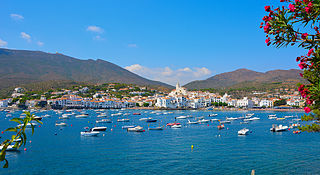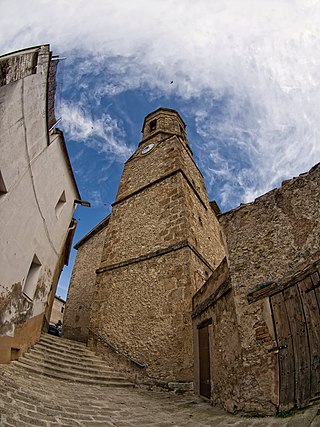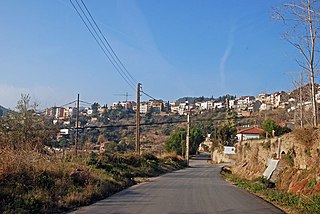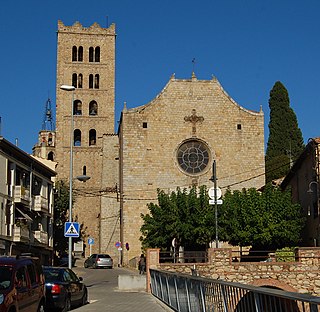
Poblet Abbey, otherwise the Royal Abbey of Santa Maria de Poblet, is a Cistercian monastery, founded in 1151, located at the foot of the Prades Mountains, in the comarca of Conca de Barberà, in Catalonia (Spain). It was founded by Cistercian monks from France. The main architect was Arnau Bargués.

The former Hospital de la Santa Creu i Sant Pau in the neighborhood of El Guinardó, Barcelona, Catalonia, Spain, is a complex built between 1901 and 1930. It is one of the most prominent works of the Catalan modernisme architect Lluís Domènech i Montaner. The complex was listed as a Conjunto Histórico in 1978. Together with Palau de la Música Catalana, it was declared a UNESCO World Heritage Site in 1997.

Cadaqués is a town in the Alt Empordà comarca, in the province of Girona, Catalonia, Spain. It is on a bay in the middle of the Cap de Creus peninsula, near Cap de Creus cape, on the Costa Brava of the Mediterranean. It is a two-and-a-quarter-hour drive from Barcelona, and thus it is accessible not only to tourists but also to people who want a second home for weekends and summers. In 2018, Cadaqués had an official population of 2,752, but up to ten times as many people can live in the town during the peak of the summer tourism season.

Lluís Domènech i Montaner was a Catalan architect who was very much involved in and influential for the Catalan Modernisme català, the Art Nouveau/Jugendstil movement. He was also a Catalan politician.

The Monastery of Santa Maria de Santes Creus, is a former Cistercian monastery in the municipality of Aiguamúrcia, Catalonia, Spain. The abbey was erected in the 12th century, in today's municipality of Aiguamúrcia, in the village of Santes Creus, in the province of Tarragona (Catalonia). However, it was in the thirteenth century when Peter III of Aragon expressed his desire to be buried in the monastery and a royal crypt was built for himself and his son, King James II that many of the local nobility established the custom to choose this place for burial. This led the monastery to increase in splendor and greatness thanks to the numerous donations received.

Santa Maragarida de Montbui is a municipality in the comarca of the Anoia in Catalonia, Spain. It is situated in the Òdena Basin, immediately to the west of Igualada of which it effectively forms a suburb. The ajuntament is in Sant Maure. Other neighbourhoods in Montbui are the Old Town, el Saió-Coll del Guix and La Mallola.

Molins de Rei or Molins de Rey in Spanish is a municipality located 18 km from Barcelona's city centre, in the comarca of Baix Llobregat in Catalonia, Spain. It is situated on the left bank of the Llobregat river, on the A-7 autopista from Valencia to La Jonquera and the main N-II road.

Sant Martí de Biure is a tenth-century Romanesque church located in the municipality of Sagàs, Catalonia, northern Spain.

Sant Feliu de Codines is a municipality in the comarca of Vallès Oriental, Catalonia, Spain. It is located in the north-west corner of the comarca, on the border with comarca of Moianès to the north, and the comarca of Vallès Occidental to the west.

Josep Maria Subirachs i Sitjar was a Spanish sculptor and painter of the late 20th century. His best known work is probably the Passion Facade of the basilica of the Sagrada Família in Barcelona. He was controversial, as he did not make any concessions to the style of the architect who designed the building, Antoni Gaudí.

Vallbona Abbey, otherwise the Monastery of Santa Maria de Vallbona, is a Cistercian nunnery in Vallbona de les Monges, in the comarca of Urgell, Catalonia, Spain. Founded in the early 12th century, and built between then and the 14th century, it is one of the most important monastic sites in Catalonia. Its church represents an example of transition between Romanesque and Gothic architecture. The abbey was declared a national monument on 3 June 1931.

The Monastery of Pedralbes, otherwise the Royal Monastery of Santa Maria de Pedralbes is a Gothic monastery in Barcelona, Catalonia, Spain. It is now a museum, housing permanent exhibitions on its own art and legacy as well as third-party special exhibitions from time to time. The Chapel of St. Michael was restored and re-opened in 2018.

The Palau Reial Major is a complex of historic buildings located in Plaça del Rei, Barcelona, Catalonia, Spain. It was a residence of the counts of Barcelona and kings of Aragon. It is composed of three distinct edifices:

The Museu Tèxtil i d'Indumentària, in English Textile and Clothing Museum, was a museum opened on 1982 and located in the Palau Reial de Pedralbes in Barcelona. The museum possessed countless objects and pieces of major artistic and historical value that make up their collections of garments, fabrics and jewellery. Regarding their collection of clothes, the museum allowed you to take a journey through the history of textiles, from the 16th century right up to the modern day. The museum's collections included Coptic, Hispano-Arab, Gothic and Renaissance fabrics, as well as embroidery, a section on lacework and a collection of prints. The jewelry collection comprised approximately five hundred pieces that were made and produced in Spain.

Sant Salvador de Breda is a parish church and former Benedictine monastery in Breda, Province of Girona, Catalonia, Spain.

Antoni Viladomat i Manalt was a Spanish painter in the Baroque style.

The Legend of the Four Blood Bars is an heraldic legend about the origins of the Senyera Reial that appeared for the first time in 1551 at Segunda parte de la crónica general de España, a chronicle edited by Pere Antoni Beuter in Spanish in Valencia. This legend places the Senyera Reial origins on Wilfred the Hairy. Specifically, it narrates that the sign of the four bars was created after a battle against the Normans, when the King of the Franks doused his hands in the blood of Wilfred the Hairy's injuries. After swiping his fingers over the golden shield of the Earl of Barcelona he said: "These will be your arms, Earl".

Public art in Barcelona is a designated group of monuments and outdoor sculptures in the city. The artworks in city's architecture and network of museums, parks, and gardens, put an artistic stamp on the Catalan capital. Public art in the city developed in the 19th century, although the first municipal commission was the 1673 monument to Saint Eulalia in Pedró Square.





























